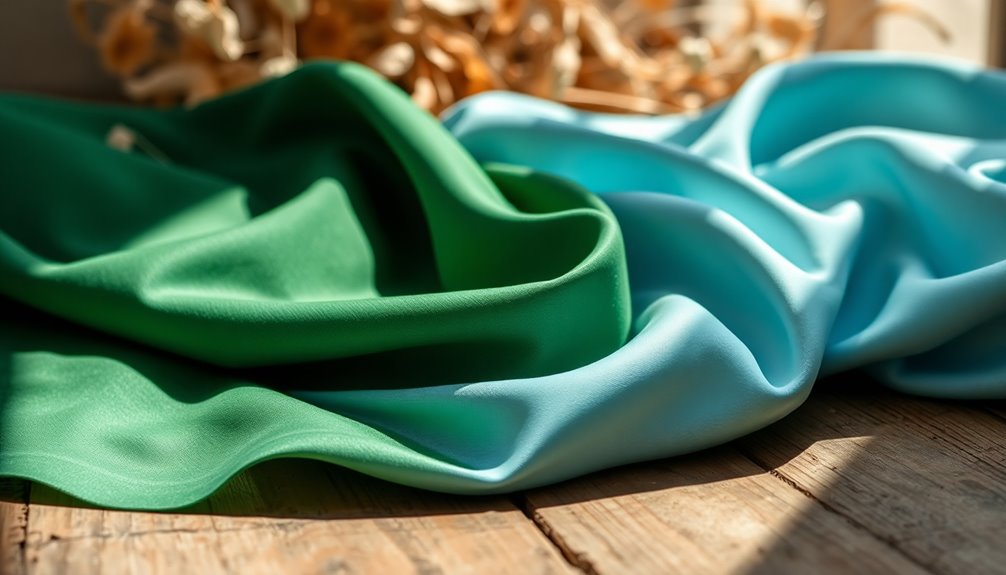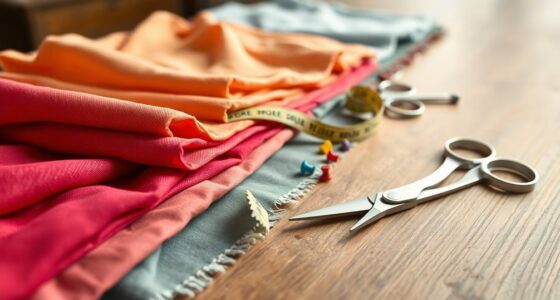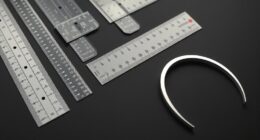TENCEL™ and lyocell both come from wood pulp, but TENCEL™ is a branded, premium version from Lenzing AG. It offers superior quality and a more consistent sustainability profile due to its eco-friendly production methods and closed-loop process. While both fibers are soft, breathable, and biodegradable, TENCEL™ excels in moisture absorption and durability. If you're considering which to choose, the differences can guide your decision, and there's more to discover about their features.
Key Takeaways
- TENCEL™ is a branded lyocell fiber known for its superior quality and consistent sustainability profile compared to generic lyocell.
- Both TENCEL™ and lyocell are biodegradable, but TENCEL™ is produced using a more environmentally friendly closed-loop process.
- TENCEL™ offers better moisture absorption, durability, and resistance to wrinkling than conventional bamboo rayon.
- For sensitive skin, TENCEL™ is hypoallergenic, making it a great choice for close-to-skin clothing.
- When choosing between TENCEL™ and lyocell, consider sustainability, softness, and the specific care requirements for each fabric type.
Understanding Tencel and Lyocell
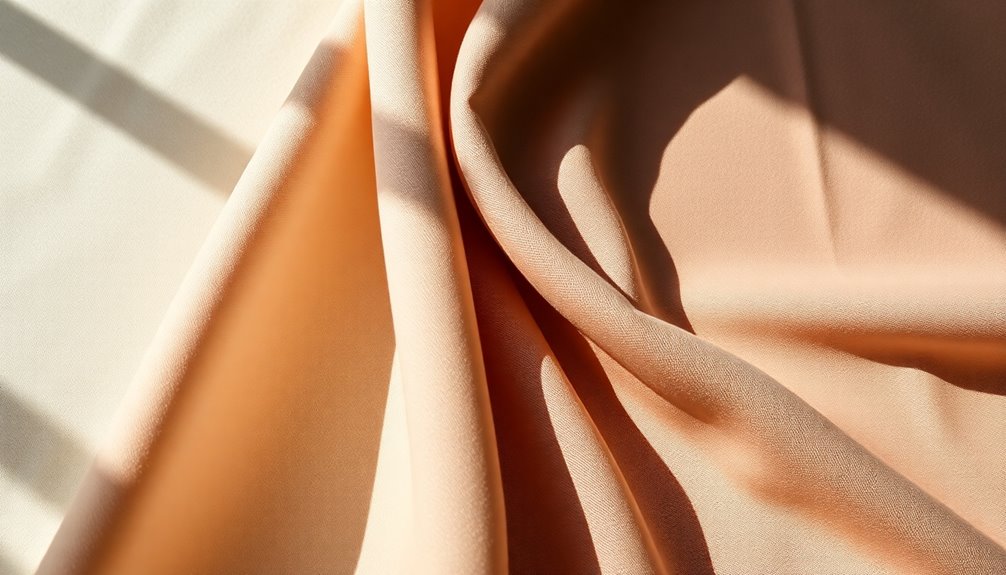
When it comes to sustainable fabrics, Tencel and lyocell often come up in conversation.
You'll find that TENCEL™ is a branded form of lyocell fiber produced by Lenzing AG, focusing on eco-friendly practices.
Both TENCEL™ and lyocell are crafted from wood pulp sourced from sustainably managed eucalyptus, beech, and spruce trees.
They utilize a closed-loop system that recycles over 99% of solvents during production, ensuring minimal environmental impact.
While all TENCEL™ fibers are technically lyocell, not every lyocell fiber carries the TENCEL™ brand, which signifies a commitment to high-quality, sustainable production practices.
Opting for TENCEL™ means you're choosing a product recognized for its luxurious softness and breathability, perfect for clothing worn close to the skin.
The History of Tencel and Lyocell Production
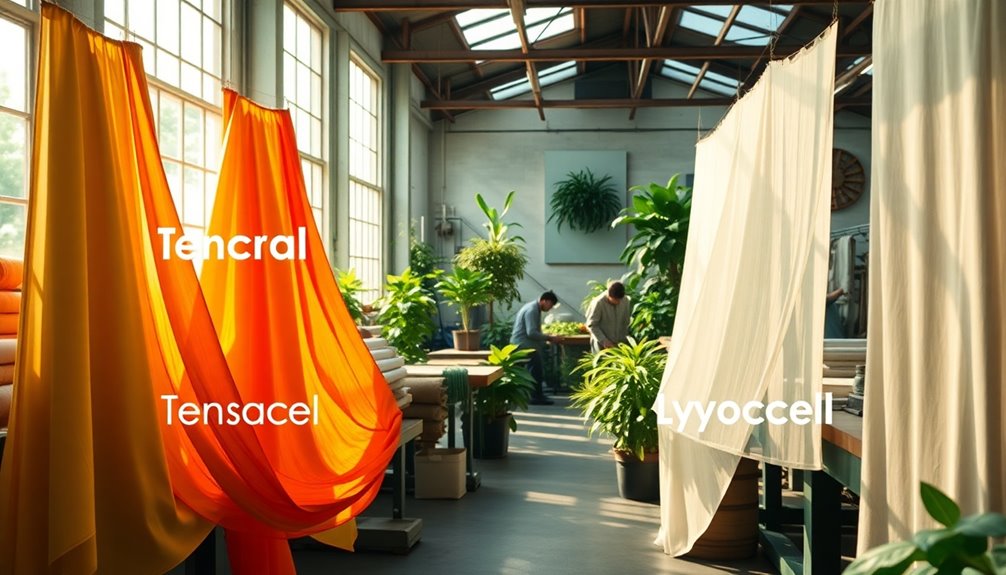
Though the journey of Tencel and lyocell production began decades ago, it has evolved considerably over the years. TENCEL™ is a brand of lyocell fibers produced by Lenzing AG, which launched its textile journey in the 1960s. The first lyocell fibers emerged in 1972, but TENCEL™ came to life in the 1980s. Lenzing AG acquired Courtaulds Fibers in 2000, furthering its impact on the industry. Importantly, TENCEL™ utilizes a closed-loop production process that recycles over 99% of solvents and water, ensuring an environmentally friendly approach. The wood sourced for TENCEL™ fibers comes from sustainably managed forests.
| Year | Event |
|---|---|
| 1938 | Lenzing begins pulp and paper production |
| 1965 | Entry into the textile industry with modal |
| 1972 | First lyocell fibers developed |
| 1980s | Launch of TENCEL™ by Courtaulds Fibers |
The Manufacturing Process: Sustainability in Focus
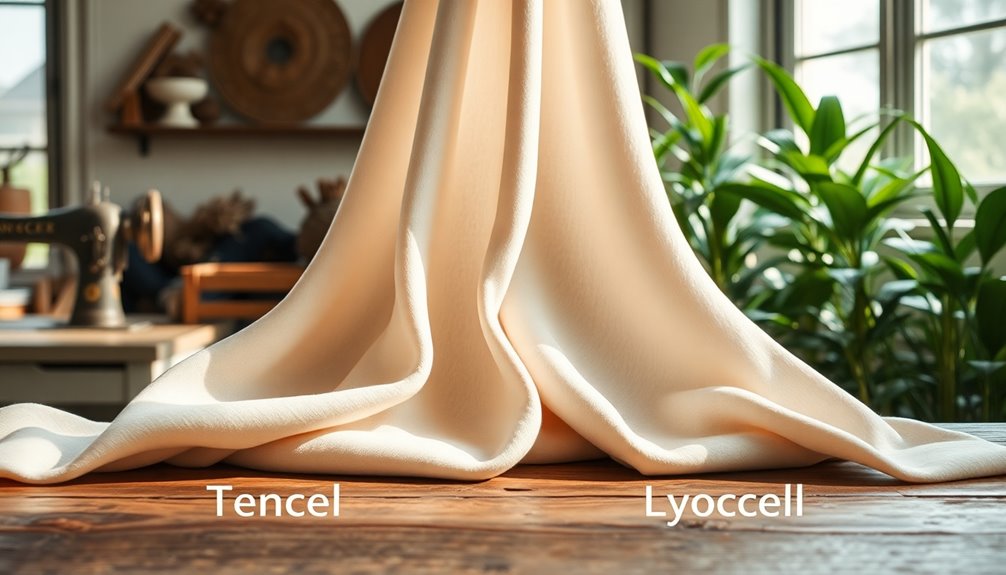
When you look at the manufacturing process behind TENCEL™ and Lyocell, sustainability takes center stage.
Both use a closed-loop system that recycles over 99% of solvents and water, greatly reducing waste.
Plus, the fibers come from sustainably sourced wood, ensuring that your choice supports eco-friendly practices.
Closed-Loop Production System
The closed-loop production system for TENCEL™ Lyocell is a game-changer in sustainable textile manufacturing, as it effectively recycles over 99% of the solvents used, drastically reducing environmental impact.
This innovative manufacturing process allows for the reuse of water and chemicals, cutting down on waste and resource consumption.
It all starts with sustainably sourced wood pulp, usually from eucalyptus, beech, or spruce trees, which is dissolved to create a cellulose solution before being extruded into fibers.
Thanks to its closed-loop approach, TENCEL™ Lyocell not only minimizes its ecological footprint but also meets strict environmental standards, ensuring that the wood comes from responsibly managed forests recognized by organizations like FSC® or PEFC™.
Choose TENCEL™ Lyocell for a more sustainable future.
Sustainable Wood Sourcing
Sourcing wood sustainably is essential in the production of TENCEL™ Lyocell fibers, as it guarantees that the materials used come from responsibly managed forests. Over 99% of the wood utilized is certified by organizations like FSC® or PEFC™, ensuring eco-conscious practices.
The primary sources include eucalyptus, beech, and spruce trees, chosen for their rapid growth on arid lands, which require less water. This sustainable approach not only supports forest health but also contributes to a lower carbon footprint. Additionally, TENCEL™ fibers are biodegradable and compostable, making them a great choice for those who prioritize sustainability in fashion. By choosing TENCEL™, you're supporting a production process that respects both the environment and future generations. Furthermore, the use of renewable energy sources in the manufacturing process further enhances the sustainability of TENCEL™ Lyocell fibers.
Key Characteristics of Tencel and Lyocell Fabrics
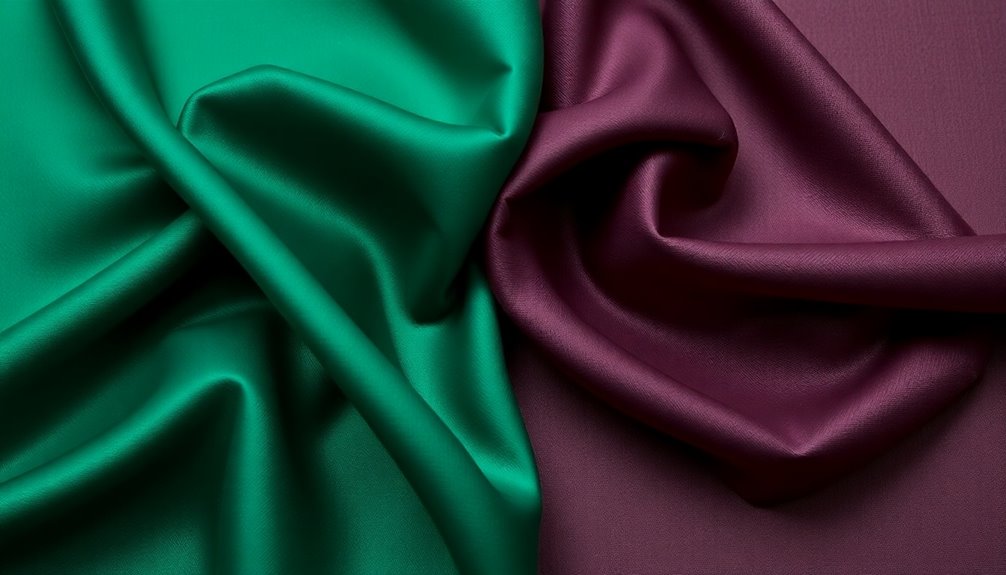
Tencel and lyocell fabrics share several key characteristics that set them apart in the world of textiles. Both are derived from natural cellulose, primarily sourced from sustainable eucalyptus and beech trees.
TENCEL™, a branded form of lyocell produced by Lenzing AG, is known for its environmentally friendly production process, utilizing a closed-loop system that recycles over 99% of solvents. This makes TENCEL™ not just soft and breathable, but also a sustainable choice.
While all TENCEL™ fabrics fall under the lyocell category, not all lyocell fabrics are TENCEL™. The focus on biodegradable and compostable materials in TENCEL™ production considerably reduces environmental impact, making it an excellent option for eco-conscious consumers.
Comparing Tencel to Other Fibers

When comparing TENCEL™ to cotton and bamboo, you'll find some notable differences in comfort and sustainability.
TENCEL™ offers superior moisture-wicking and breathability, making it a great choice for close-fitting clothing.
Plus, its eco-friendly production process sets it apart from both cotton and bamboo fibers.
Tencel vs. Cotton
While both TENCEL™ and cotton are popular choices in the textile industry, their differences can considerably impact your clothing experience. TENCEL™, derived from sustainably sourced wood pulp, excels in moisture absorption, breathability, and durability compared to traditional cotton, a natural fibre that demands high water and pesticide use.
| Feature | TENCEL™ | Cotton |
|---|---|---|
| Moisture Absorption | Superior | Moderate |
| Feel | Silky and smooth | Soft but can be rough |
| Environmental Impact | Low (closed-loop process) | High (intensive farming) |
Choosing TENCEL™ means enjoying luxurious comfort while being kinder to the environment, making it a standout option for your wardrobe.
Tencel vs. Bamboo
If you're exploring options for soft, breathable fabrics, comparing TENCEL™ and bamboo rayon reveals some significant differences.
TENCEL™, produced by Lenzing AG, uses a closed-loop system that recycles over 99% of solvents and water, making it more environmentally friendly than conventional bamboo rayon, which often involves toxic chemicals in its production.
While both fibers are biodegradable, TENCEL™ stands out for its durability and resistance to wrinkling and fading. TENCEL™ fibers are known for their incredible softness and moisture-wicking properties, ideal for close-to-skin clothing.
In contrast, bamboo rayon is often praised for its antibacterial qualities.
Ultimately, if sustainability and longevity matter to you, TENCEL™ might be the better choice.
Benefits of Tencel Lyocell for Various Uses
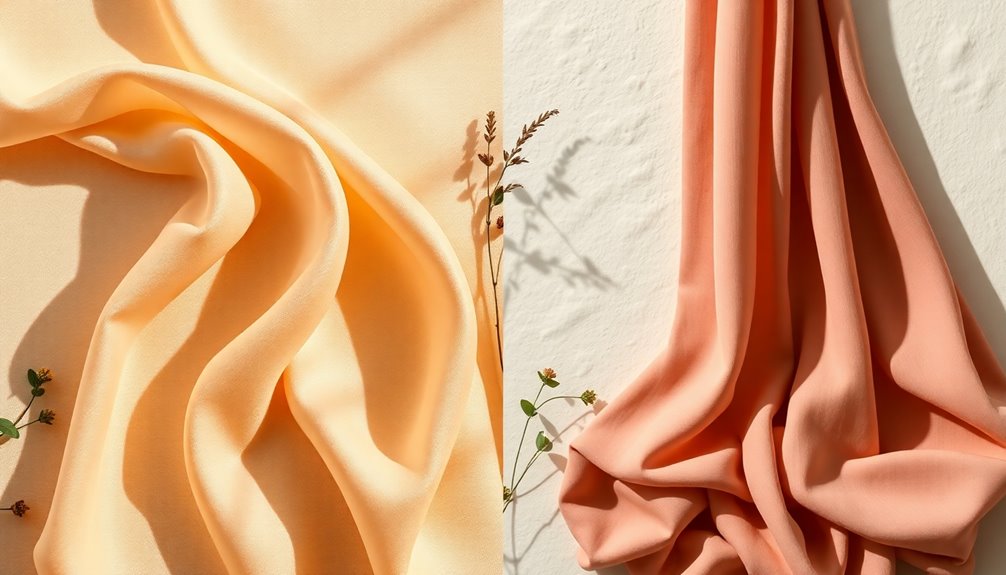
TENCEL™ Lyocell offers a range of benefits that make it an excellent choice for various applications. Its exceptional softness guarantees comfort, making it perfect for close-to-skin clothing like t-shirts and bedding.
The moisture-wicking properties quickly absorb sweat, promoting breathability in activewear and sleepwear. You'll appreciate its durability; it maintains shape and strength, ideal for sportswear and outdoor clothing.
Plus, TENCEL™ Lyocell is biodegradable, produced through a closed-loop process that recycles over 99% of solvents, appealing to eco-conscious consumers.
Its hypoallergenic nature makes it a fantastic option for sensitive skin, reducing the likelihood of irritation or allergic reactions in your clothing and linens.
With these benefits, TENCEL™ Lyocell proves to be a versatile and responsible choice.
Which Fabric Is Better for Clothing?
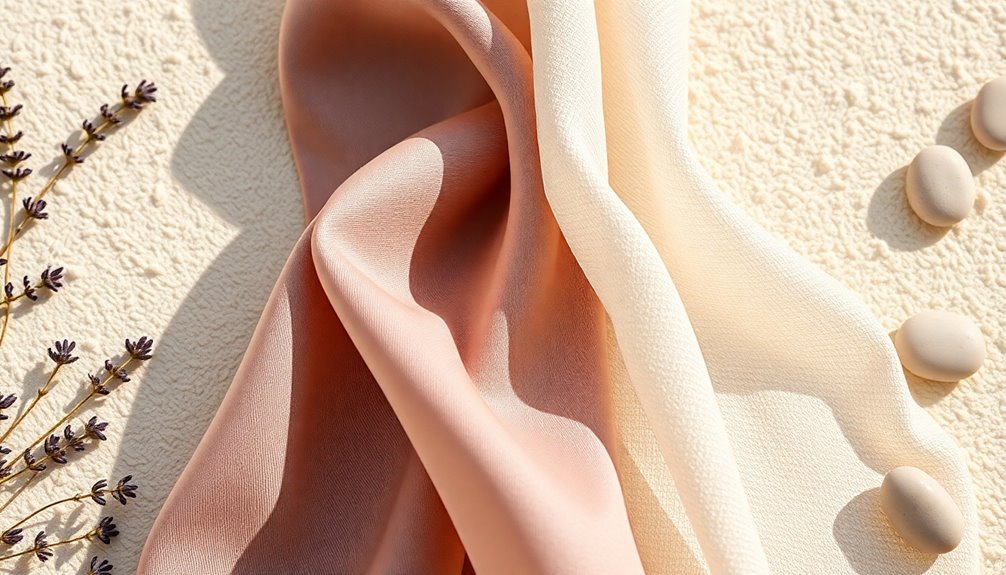
When it comes to choosing the right fabric for clothing, TENCEL™ and lyocell both stand out for their softness and breathability.
If you prioritize sustainable production, TENCEL™ is the way to go, as it's made using a closed-loop system that recycles over 99% of solvents. This makes it an eco-friendly option compared to traditional fabrics.
Both TENCEL and lyocell fabrics boast excellent moisture absorption, keeping you comfortable even on warm days.
However, TENCEL™ is marketed for its superior quality, ensuring consistency in softness and durability.
If you're looking for clothing that feels great against your skin while being environmentally responsible, TENCEL™ is your best choice.
In contrast, non-branded lyocell may vary, so be cautious when selecting it.
Care Instructions for Tencel and Lyocell
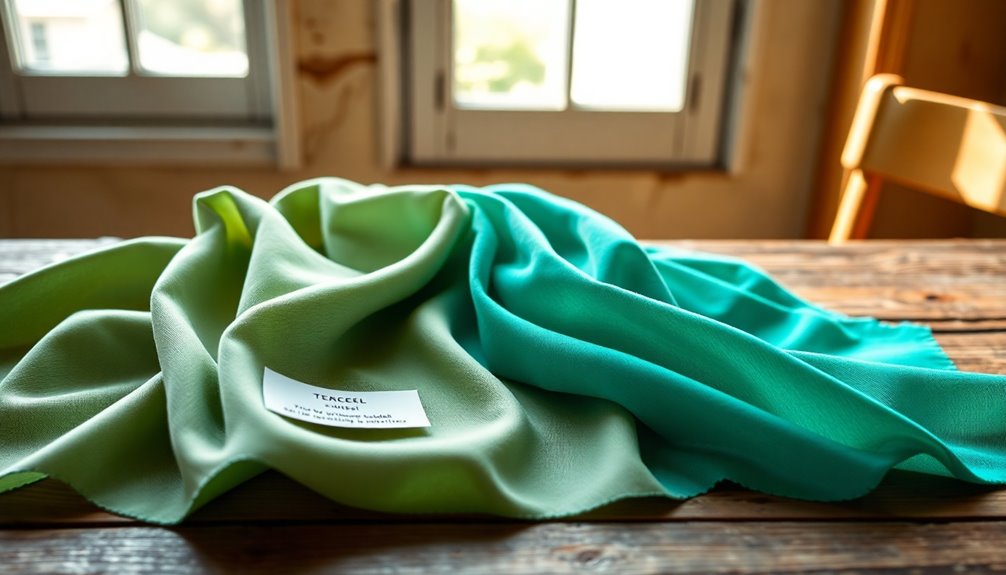
When it comes to caring for TENCEL™ and lyocell, you'll want to follow some specific washing guidelines.
Both fabrics do best on a delicate cycle, and keeping the water temperature below 30°C (86°F) will help prevent damage.
For ironing, remember to use low to medium heat with steam, ensuring you don't burn the fabric.
Washing Guidelines
Caring for Tencel and lyocell fabrics is essential to keep them looking their best. Follow these washing guidelines to maintain quality and extend their lifespan.
Machine wash these delicate fabrics on a gentle cycle with cold water to prevent damage. Use a mild detergent designed for delicate fabrics to avoid harsh chemicals that could degrade the fibers.
To prevent fading and maintain color vibrancy, turn your garments inside out before washing and avoid prolonged exposure to direct sunlight.
Instead of using a dryer, hang your items to dry, as this helps preserve their smooth appearance.
Ironing Recommendations
To keep your Tencel and lyocell fabrics looking their best, you'll want to use low to medium heat settings while ironing. This helps prevent burn marks and preserves the softness of the material.
To protect the sheen, especially on darker colors, always place a pressing cloth between the iron and the fabric.
Both Tencel and lyocell tend to wrinkle, so steaming the fabric before wear can smooth out those pesky creases effectively.
For best results, iron while the fabric is slightly damp to achieve a smoother finish and reduce the risk of damage from overheating.
Finally, don't forget to check the care label for any specific manufacturer's recommendations regarding ironing.
Environmental Impact: Tencel vs. Lyocell
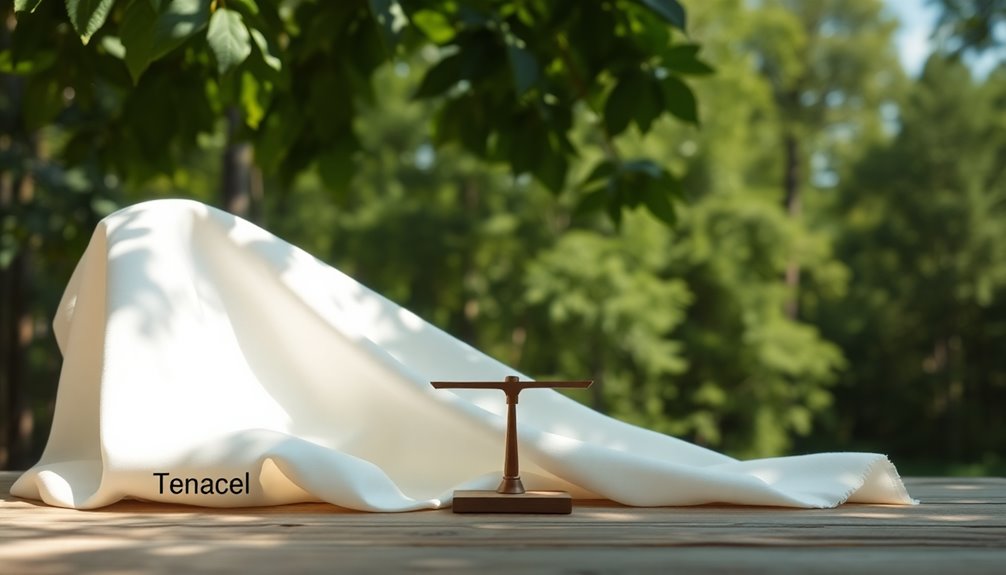
While both Tencel and lyocell originate from similar raw materials, their environmental impacts can differ greatly.
TENCEL™ Lyocell is produced using a closed-loop system, recycling over 99% of solvents and water, which considerably reduces environmental waste. The wood for TENCEL comes from sustainably managed forests, certified by reputable organizations like FSC® or PEFC™, ensuring responsible forestry practices.
In contrast, non-branded lyocell can vary in sustainability, so it's essential to verify sourcing. Additionally, TENCEL™ Lyocell uses non-toxic solvents and avoids harmful chemicals found in traditional viscose rayon production.
Plus, its biodegradability allows it to decompose naturally, returning to the environment without harmful residues. Overall, TENCEL offers a more sustainable choice with a lower environmental impact.
Choosing the Right Fabric for Your Needs
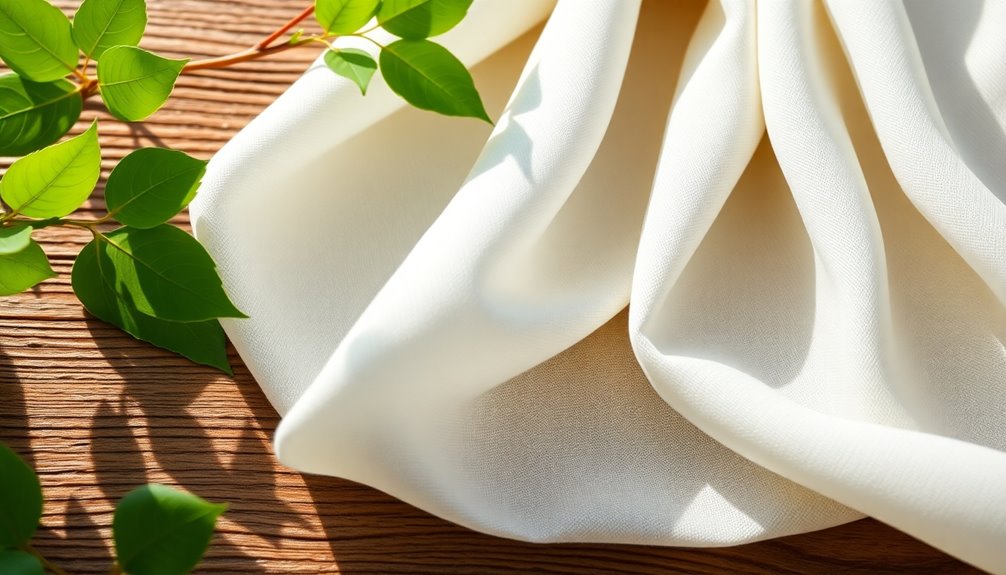
When it comes to selecting the right fabric for your needs, understanding the differences between TENCEL™ and generic lyocell can guide your decision. If you're prioritizing sustainability, TENCEL™ is an excellent choice due to its eco-friendly production methods and responsible sourcing of wood pulp. Consider the softness and breathability of TENCEL™ fibers, making them perfect for close-to-skin clothing. Both fabrics are biodegradable, but TENCEL™'s closed-loop production process enhances its environmental profile. Additionally, the growing demand for transparency in private equity investments is mirrored in the fabric industry as consumers seek more information about the sourcing and production of textiles.
| Feature | TENCEL™ | Generic Lyocell |
|---|---|---|
| Sustainability | FSC® or PEFC™ certified | Varies by manufacturer |
| Softness | Superior | Good |
| Environmental Impact | Closed-loop process | Standard production |
Choose wisely for your next fabric purchase!
Frequently Asked Questions
Which Is Better, Tencel or Lyocell?
When considering which is better, TENCEL™ or lyocell, you should focus on quality and sustainability.
TENCEL™ fibers are produced under strict environmental standards, ensuring superior moisture-wicking and breathability.
If you value eco-friendly practices, TENCEL™'s closed-loop production system, which recycles over 99% of solvents, stands out.
Choosing TENCEL™ guarantees higher consistency and recognized certifications, giving you peace of mind about your clothing's environmental impact.
What Is the Disadvantage of Tencel Fabric?
Have you ever considered the downsides of Tencel fabric?
While it's known for its softness and sustainability, it has some drawbacks. Tencel can be pricier, which mightn't suit your budget.
It's also prone to wrinkling, especially in lighter weights, so you'll need to handle it with care.
Plus, it may not hold its shape as well as synthetic fibers, impacting the longevity of your garments.
What Are the Disadvantages of Lyocell?
When considering lyocell, you might find a few disadvantages.
It can be pricier than cotton or traditional rayon due to its sustainable production.
While it's durable, it may not hold up as well as linen or cotton when wet.
You'll also notice it wrinkles easily, requiring careful handling.
Additionally, lyocell tends to attract lint and pet hair, so you may need to clean it more frequently to keep it looking fresh.
Does Lyocell Wrinkle a Lot?
Imagine stepping out in a perfectly crisp outfit, only to discover unsightly wrinkles later.
When it comes to Lyocell, you'll find it's more resistant to wrinkling than many other fabrics. While it's not completely wrinkle-free, its smooth surface helps maintain a polished look.
Lighter weights might crease more, but with proper care—like hanging to dry—you can enjoy a sleek appearance with minimal effort, making it ideal for your everyday adventures.
Conclusion
In choosing between Tencel and Lyocell, you might discover more than just a fabric; you'll uncover a reflection of your values. Both offer comfort and sustainability, yet each has its unique charm. As you weigh your options, consider how the fabric aligns with your lifestyle and environmental goals. Coincidentally, this decision could lead you to a deeper connection with your clothing and the world around you, reminding you that every choice we make weaves into the larger story of our lives.
